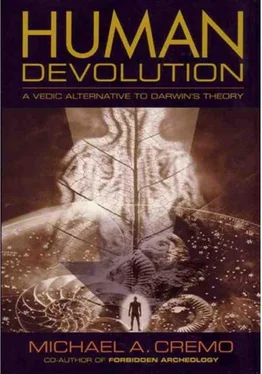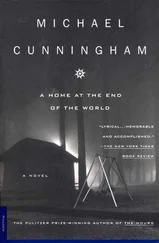Michael Cremo - Human Devolution - A Vedic Alternative To Darwin's Theory
Здесь есть возможность читать онлайн «Michael Cremo - Human Devolution - A Vedic Alternative To Darwin's Theory» весь текст электронной книги совершенно бесплатно (целиком полную версию без сокращений). В некоторых случаях можно слушать аудио, скачать через торрент в формате fb2 и присутствует краткое содержание. Год выпуска: 2003, ISBN: 2003, Издательство: Torchlight Publishing, Жанр: Старинная литература, на английском языке. Описание произведения, (предисловие) а так же отзывы посетителей доступны на портале библиотеки ЛибКат.
- Название:Human Devolution: A Vedic Alternative To Darwin's Theory
- Автор:
- Издательство:Torchlight Publishing
- Жанр:
- Год:2003
- ISBN:9780892133345
- Рейтинг книги:4 / 5. Голосов: 1
-
Избранное:Добавить в избранное
- Отзывы:
-
Ваша оценка:
- 80
- 1
- 2
- 3
- 4
- 5
Human Devolution: A Vedic Alternative To Darwin's Theory: краткое содержание, описание и аннотация
Предлагаем к чтению аннотацию, описание, краткое содержание или предисловие (зависит от того, что написал сам автор книги «Human Devolution: A Vedic Alternative To Darwin's Theory»). Если вы не нашли необходимую информацию о книге — напишите в комментариях, мы постараемся отыскать её.
Human Devolution: A Vedic Alternative To Darwin's Theory — читать онлайн бесплатно полную книгу (весь текст) целиком
Ниже представлен текст книги, разбитый по страницам. Система сохранения места последней прочитанной страницы, позволяет с удобством читать онлайн бесплатно книгу «Human Devolution: A Vedic Alternative To Darwin's Theory», без необходимости каждый раз заново искать на чём Вы остановились. Поставьте закладку, и сможете в любой момент перейти на страницу, на которой закончили чтение.
Интервал:
Закладка:
In terms of modern discussion of the mind/body question, Wallace would be a dualist. He accepted the existence of a conscious self distinct from the physical body. Wallace noted that the bodies of organisms, from primitive to advanced, were built up from molecules, arranged in ever increasing complexity. More, however, was needed to explain consciousness. “If a material element, or a combination of a thousand material elements in a molecule, are all alike unconscious, it is impossible for us to believe, that the mere addition of one, two, or a thousand other material elements to form a more complex molecule, could in any way produce a self-conscious existence. The things are radically distinct . . . There is no escape from this dilemma,—either all matter is conscious, or consciousness is something distinct from matter, and in the latter case, its presence in material forms is a proof of the existence of conscious beings, outside of, and independent of, what we term matter” (Wallace 1870; in Smith
1991, p. 290).
Wallace favored the latter course, but his system has certain puzzling features. Although a dualist, he does not appear to accept the existence of individual conscious entities before their earthly embodiment. According to Wallace, there is an original spiritual mind from which matter is generated. Individual spiritual minds, associated with spiritual bodies (souls), are only developed from and in material bodies, as they come into existence (Wallace 1885b; in Smith 1991, p. 100). After death, the individual minds, as above stated, go to “the first grade of spirit life,” where they experience progress or the lack of it based on their earthly habits. But if individual spirit souls can exist after earthly embodiment, why not before? And why is there any need at all for earthly embodiment, which is not an altogether pleasant experience? Why not skip that and go directly to the highest grade of spiritual life?
A system in which there is preexistence of spirit beings offers a solution. According to Wallace, spirit has free will, and as a result suffers or enjoys the consequences of its actions after death. So if we allow that souls exist before their material embodiment, and also possess free will, we could explain the embodiment of some of these souls by misuse of the same free will. Only those souls who misused their free will would suffer embodiment, which does seem to have some unpleasant features, such as inevitable disease and death.
Here is another problem with Wallace’s system. In his works, Wallace details reports of varied spiritualistic phenomena, such as levitation, ap-paritions, and clairvoyance, from his own time and throughout history. But he ignores reports of transmigration of souls, which occur widely in almost all times and places. The reports of transmigration are just as credible as any other category of evidence he considers. The existence of this phenomenon requires, however, certain modifications in Wallace’s system. At death, souls would pass not necessarily into the first phase of spiritual existence but perhaps into new material bodies. According to religious systems that incorporate transmigration, such as the Vedic system, some souls, because of their strong attachment to their last embodiment, do not attain new material bodies, but remain for some time as ghosts. This actually fits in quite well with the observations of Wallace and other spiritualists, who found that the spirits they contacted often desired to communicate with living friends and relatives.
Wallace’s Spiritualism and evolution
How did Wallace incorporate his spiritualist ideas into his theory of evolution by natural selection? Specifically, how did his spiritualist ideas relate to his theory of human origins? First of all, Wallace believed that evolution was in some sense directed. Although the origin of species was in general governed by natural selection, natural selection was, in his opinion, not sufficient to account for the exact variety of species we encounter today. Some forces, the nature of which were not clearly understood, and which perhaps never could be understood, shaped the path that evolution by natural selection followed.
Stephen J. Gould, an influential modern evolutionary theorist, has proposed that if we “ran the tape” of evolution again we would not get the same result. For example, we might not get human beings. Indeed, we might “run the tape” a thousand different times and get a thousand different sets of species. In other words, there is a certain contingency rather than inevitability to the evolutionary process. There are so many variables that one cannot predict in advance the path evolution will follow. If there are so many paths, each of which is dependent on millions of accidental occurrences, great and small, then this leaves open the possibility for an original Mind to manipulate the process to get a specific result.
Given a certain initial condition and a desired end result, the Minddirected pathway, mediated by natural selection, might contain a lot of strange features one would not expect from a Creator, but it would nevertheless be guided and intentional. For example, the panda has a thumblike appendage that it uses to grasp bamboo shoots, its favorite food. Gould points out that the so-called thumb is not a real digit but an outgrowth from the panda’s wrist. God would never have created the panda’s “thumb,” says Gould. Only natural selection could account for such a weird, quirky adaptation. But God and natural selection were, for Wallace, not mutually exclusive. The original Mind could have guided the path of natural selection in a certain direction to get human beings as an end result. And one of the byproducts may have been the panda, with its strange thumb.
Let us consider in more detail the source of guidance in Wallace’s system of guided evolution. Anticipating Einstein, Wallace considered matter to be a transformation of force, or energy (Wallace 1870, in Smith 1991, p. 290). Force existed in two varieties: “The first consists of the primary forces of nature, such as gravitation, cohesion, repulsion, heat, electricity, etc.; the second is our own will force” (Wallace 1870, in Smith 1991, p. 290). The ancient question of free will remains an unresolved problem for most philosophers and scientists right up to the present. Foregoing a review of the entire debate, I shall here simply reproduce the main features of Wallace’s argument.
Wallace observed that many persons suggest free will is “but the result of molecular changes in the brain” (Wallace 1870, in Smith 1991, p. 291). But he countered that no one has ever proved that all force exhibited in a body can be attributed to known primary forces of nature. Accepting the existence of free will as an observed feature of human consciousness, he proposed that its exercise must involve the exertion of a force capable of setting into motion the other natural forces exhibited in organisms. In this sense, the action of natural forces in an organism could be ultimately traced to the action of will force. This led Wallace to conclude: “If, therefore, we have traced one force, however minute, to an origin in our own WILL, while we have no knowledge of any other primary cause of force, it does not seem an improbable conclusion that all force may be will-force; and thus, that the whole universe, is not merely dependent on, but actually is, the WILL of higher intelligences or of one Supreme Intelligence” (Wallace 1870; in Smith 1991, p. 291). In other words, all matter and force in the universe are transformations of the will of a Supreme Intelligence, or intelligences.
The will of higher intelligences, according to Wallace, guided the process of evolution by natural selection. Wallace stated: “A superior intelligence has guided the development of man in a definite direction, and for a special purpose, just as man guides the development of many animal and vegetable forms. The laws of evolution alone would, perhaps, never have produced a grain so well adapted to man’s use as wheat and maize; such traits as the seedless banana and bread-fruit; or such animals as the Guernsey milch cow, or the London dray-horse. Yet these so closely resemble the unaided productions of nature, that we may well imagine a being who had mastered the laws of development of organic forms through past ages, refusing to believe that any new power had been concerned in their production, and scornfully rejecting the theory (as my theory will be rejected by many who agree with me on other points), that in these few cases a controlling intelligence had directed the action of the laws of variation, multiplication, and survival, for his own purposes. We know, however, that this has been done; and we must therefore admit the possibility that, if we are not the highest intelligence in the universe, some higher intelligence may have directed the process by which the human race was developed, by means of more subtle agencies than we are acquainted with (Wallace 1870, pp. 359–360; in Smith 1991, p. 289).
Читать дальшеИнтервал:
Закладка:
Похожие книги на «Human Devolution: A Vedic Alternative To Darwin's Theory»
Представляем Вашему вниманию похожие книги на «Human Devolution: A Vedic Alternative To Darwin's Theory» списком для выбора. Мы отобрали схожую по названию и смыслу литературу в надежде предоставить читателям больше вариантов отыскать новые, интересные, ещё непрочитанные произведения.
Обсуждение, отзывы о книге «Human Devolution: A Vedic Alternative To Darwin's Theory» и просто собственные мнения читателей. Оставьте ваши комментарии, напишите, что Вы думаете о произведении, его смысле или главных героях. Укажите что конкретно понравилось, а что нет, и почему Вы так считаете.












